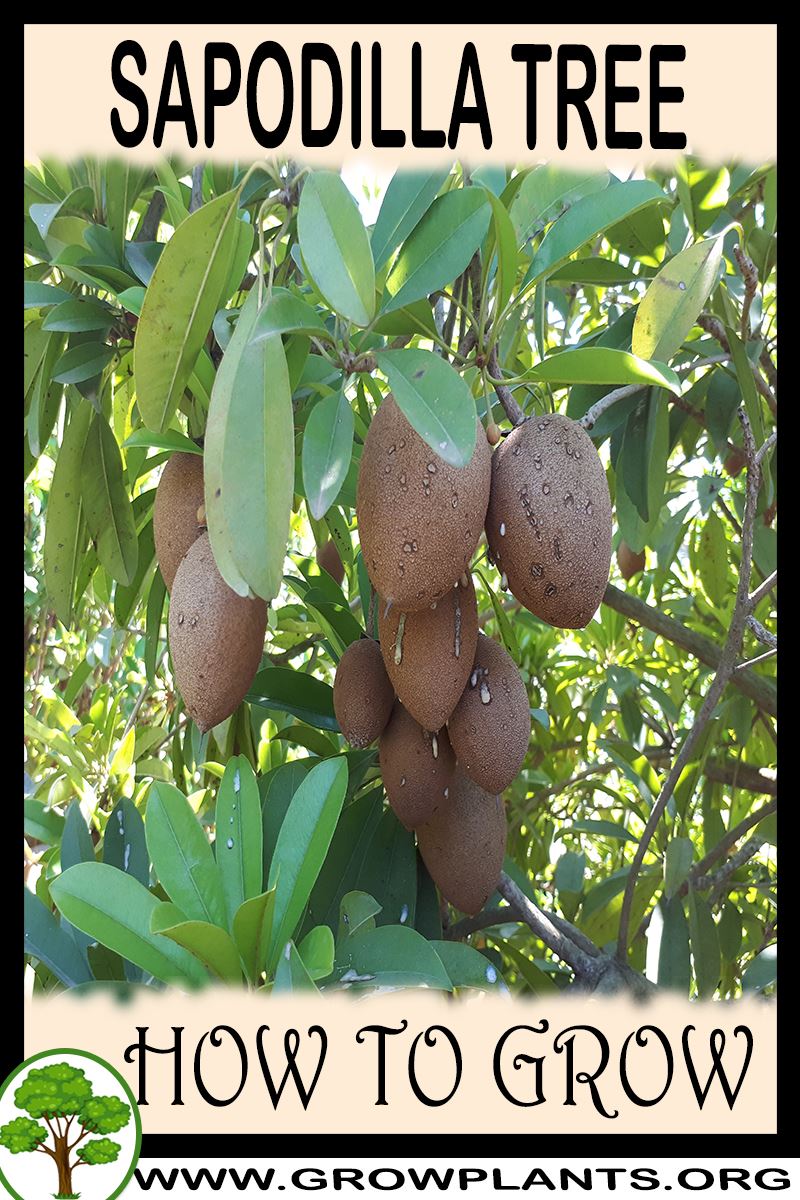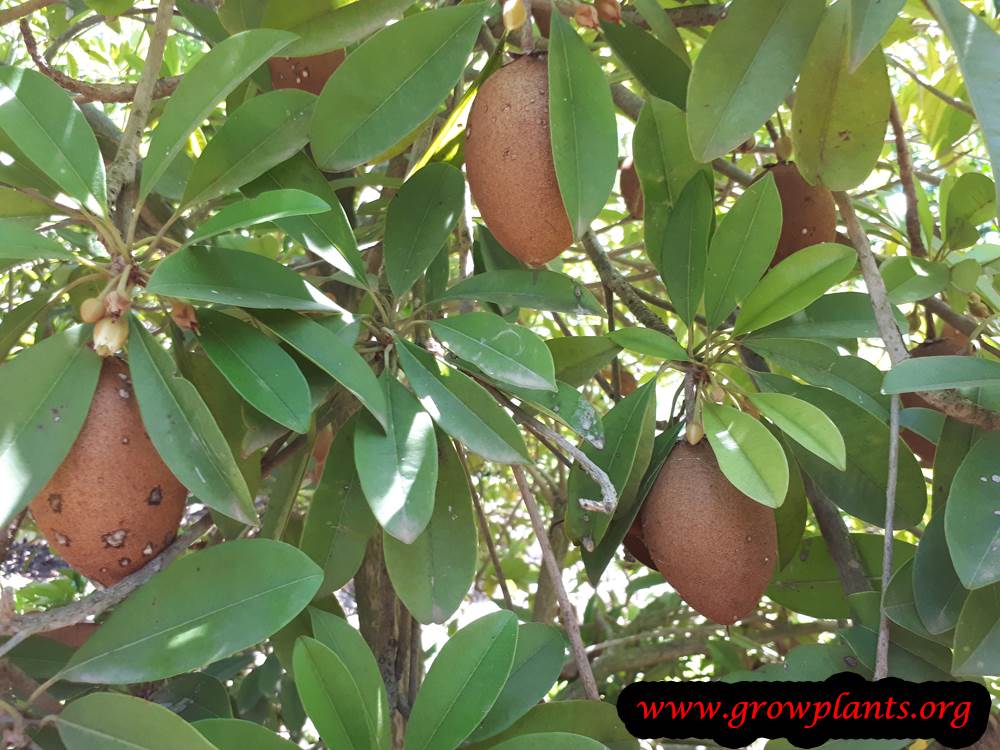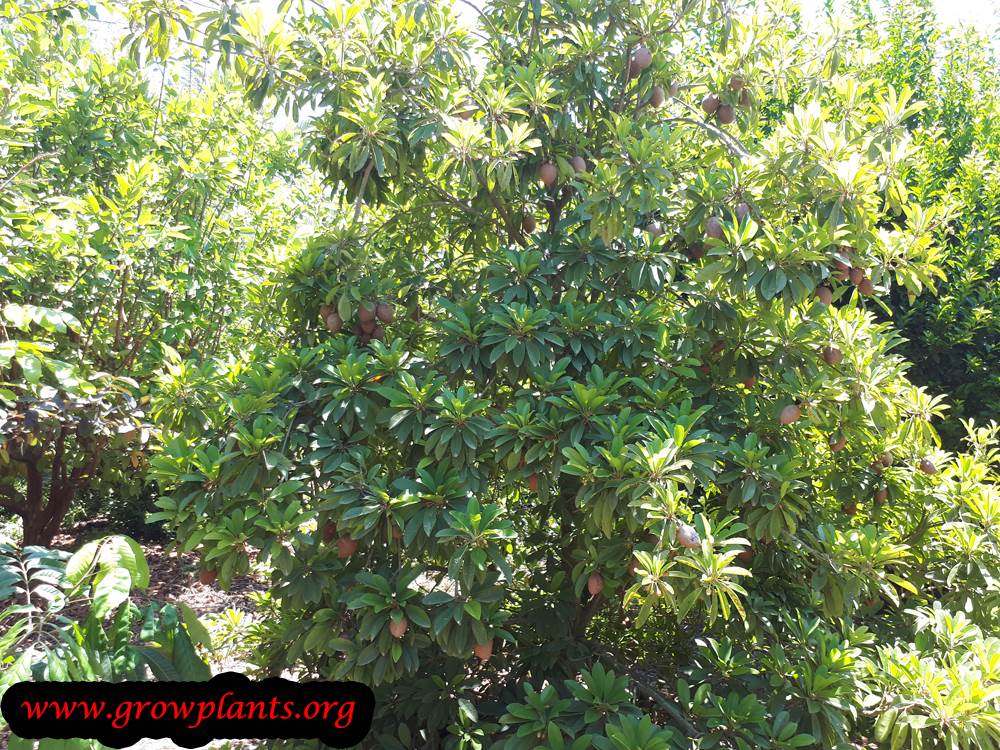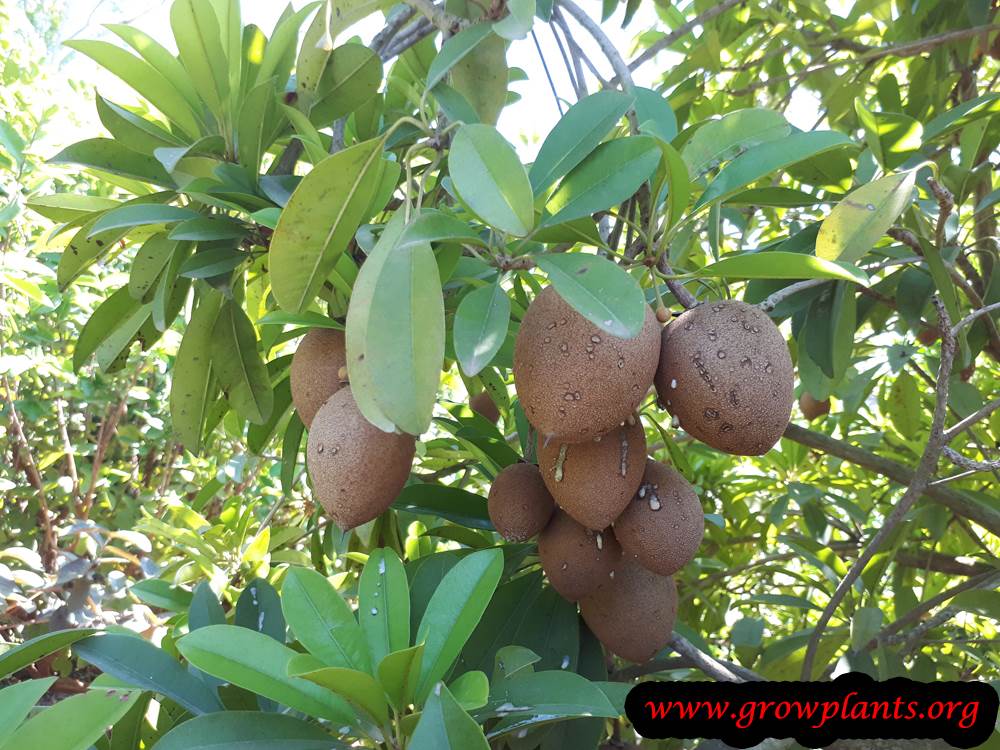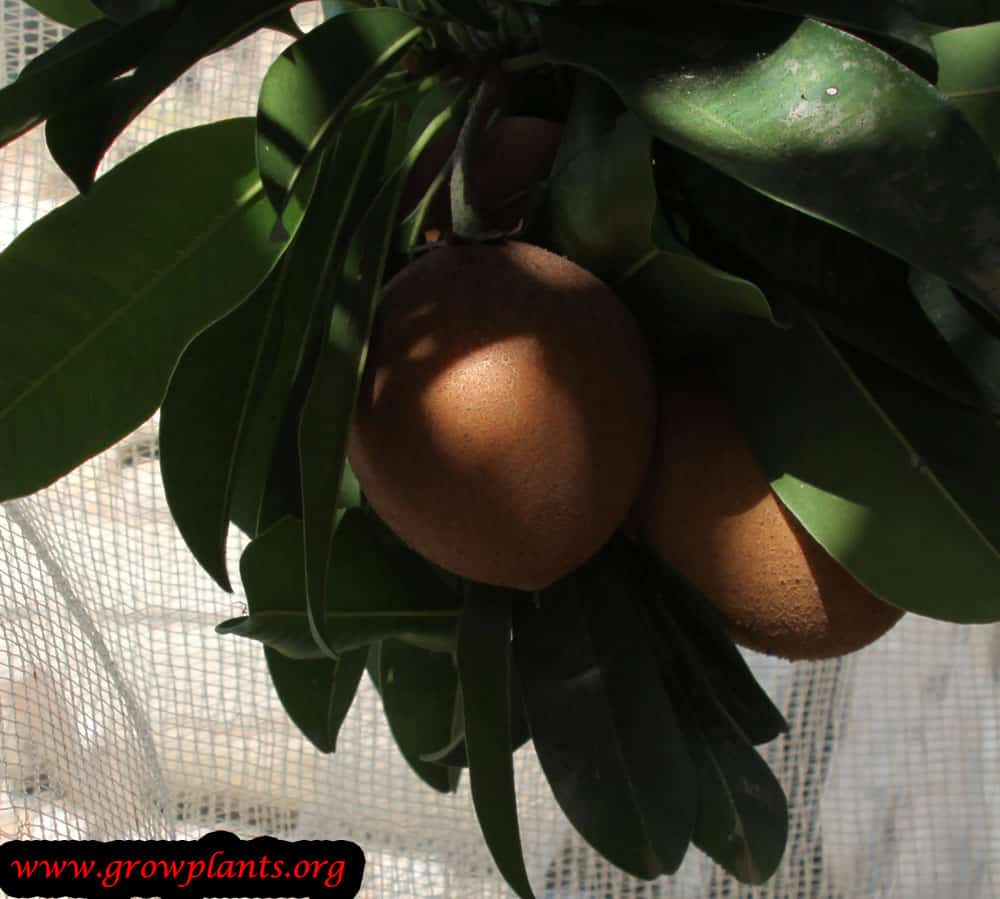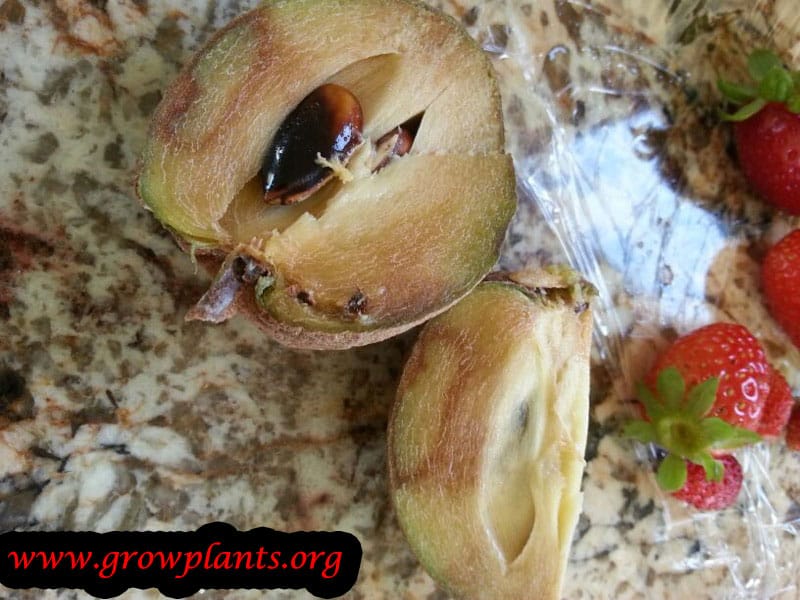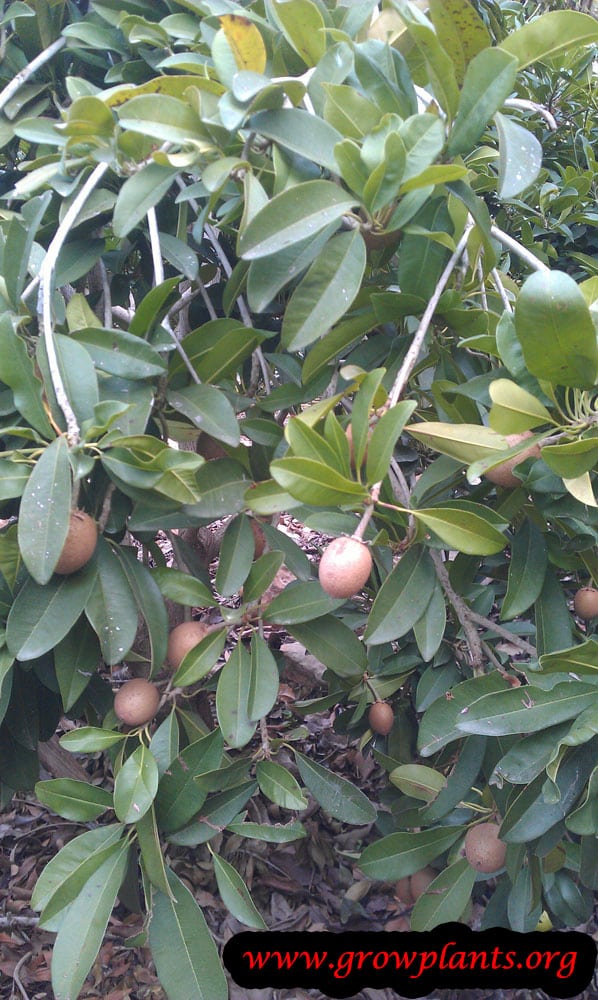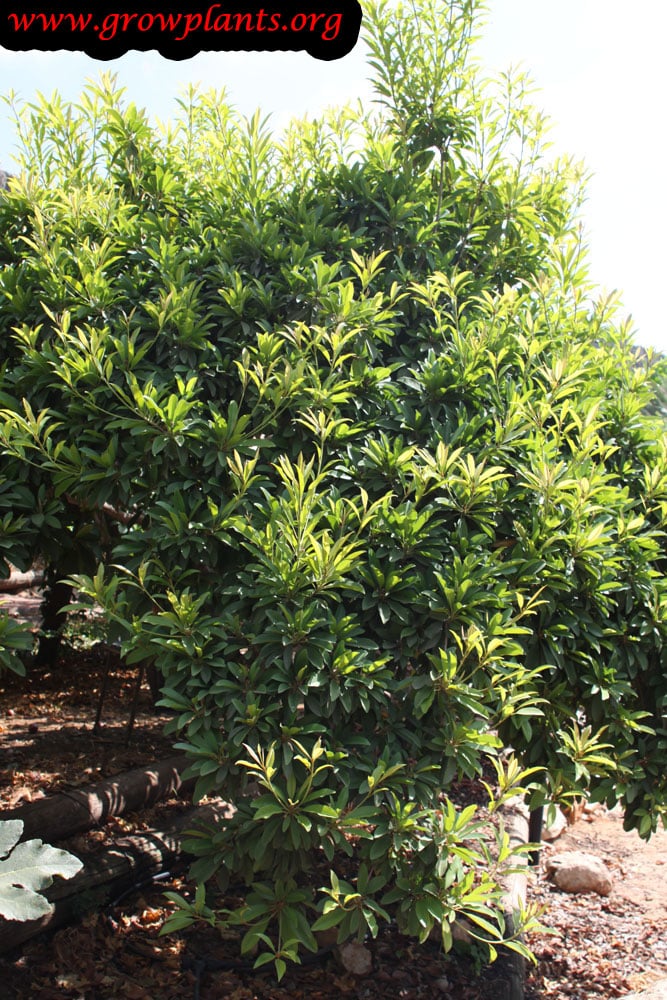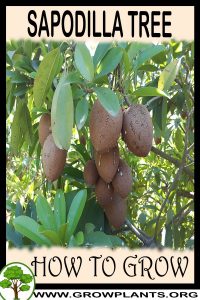
Sapodilla tree grow and care tree of the genus Manilkara also known as Manilkara zapota or Nispero, Sapodilla tree perennial evergreen to cold weather become deciduous plant, grown for the edible fruits and can also use as ornamental plant, grow in tropic, mediterranean or subtropical climate and growing in hardiness zone 10b+ and with the right overwinter care especially when the plant young in hardiness growing zone 10a.
Leaves color green can be light to dark green and the leaves can be glossy but not all the year.
Flowers color yellow-brown hairy in small bell-shaped, flowers, three sepals and six stamens.
Sapodilla tree edible fruits
Fruit elliptic, size 5-10 cm, the peel is brown and hairy, the peel can be edible after cleaning, fruits inner side yellow to brown, taste is sweet and remind with imagination mix taste of date palm and pear
Sapodilla tree for sale – Seeds or Plants to Buy
How to grow Sapodilla tree growing and care:
Better frost free, rich soil, organic matter, tree deciduous in hardiness zone 10a when the tree young, mulch to keep the soil moist
How to care:
Add fertilizer, put mulch especially in the winter, humus and organic matter, when grow in hardiness zone 10a must protect the plant when the plant young when the tree mature it’s more suitable to manage frost, in hardiness zone 10b better to protect the trees in the winter when young.
What is the best way to start growing?
Plant / Seed (explanation bellow) / Vegetative Reproduction – cutting
How to propagate by cutting:
Propagation by cutting, when start from branch need to choose brown branch fully grown use root growth hormone that fit for woody branches, need to keep high humidity, moist soil and if put it in close box or greenhouse, need to be well ventilate that will moving of the air, watering by spraying or create fog and take care don’t let it dry, temperature of 25-29C (77-84F)
Is it necessary to graft or use vegetative reproduction?
Yes, in ordered to ensure that the tree will bear fruits and few different parameters of the fruits like: season of the fruits, size of the fruits, taste and flavour strong or week
Difficulties or problems when growing:
Some tree not bearing fruits without grafting
Planting season:
Spring in hardiness zone 10a, spring to summer in hardiness zone 10b, spring to autumn in hardiness zone 11, all year in hardiness zone 12+
How to plant:
Dig hole bigger 50-100% than the roots ball, add to the hole: organic matter, dead leaves and humus put back some soil and mix, after cover lightly but strong enough that won’t fall put support for the tree if needed, if the tree is not stable consider to prune, prune week branches and weeping, water it twice in the first day and every day for two weeks increase the amount of water until the plant establish.
Pests and diseases:
Aphids, ants, mealy bugs
Pruning season:
Winter, pruning season can be all the year especially after the fruits
How to prune:
Weak and weeping branches, infected branches, also better to cut the fruits from week branches, better in the beginning to prune all the branches that go to the side and let it grow at least 1-2m (3-6ft)
Size of the plant?
8-20 m, 24-60 feet, possible to grow it as dwarf and it will bear fruits 1.5-3m (5-10 feet)
Growth speed in optimal condition:
Slow growing especially when the tree young after few years the plant growing faster
Water requirement:
Average amount of water to big amount of water, better to add water in the fruits season
Light conditions in optimal condition for growing:
Full Sun possible in half shade but will take more years to bear fruits, in hardiness zone 10 must be in full sun if not the plant won’t survive overwinter
Is it possible to grow indoor as houseplant?
No
Growing is also possible in a planter, flowerpot, containers:
Yes, when grow in container need to limit the growth of the plant and grow it as dwarf or bonsai need to limit the growth of the roots, container need to be 50% bigger than the root ball until the plant arrive to the desirable container, wouldn’t recommend to start from big container on small tree in this method it’s care for the viability of the soil, minimum size of the container 50-100L (10-20 gallons) and bigger is better, making enough holes in the container for good drainage also choosing soil for container important an option it’s to use potting mix or peat soil with perlite and organic matter, care instruction every few years to switch the soil with big container there is no need to switch all the soil just switch part and cut some of the roots ball (can switch from the side and the top, fertilizer at least once a year, need to add humus few better twice, water it regularly and when put bottom for the pot be aware not to let the water stay there more than one day and do not over water it’s destroy the soil and the roots, consider to graft in order to get good quality of fruits or start by cutting.
Blooming information
Bloom season:
Spring to autumn, in different climate bloom in different season
General information about the flower
Small bell-shaped flowers, brown hairy flowers, three sepals and six stamens
Pollination is done by:
Bees
Edible fruits
Fruit harvest season:
Autumn to winter in tropical, in hardiness zone 10-11 summer to autumn, in hardiness zone 11-12 possible all the year, usually 8-10 month after the bloom
Fruits pests or diseases:
Aphids, ants, birds
What can be done with big quantities of Sapodilla tree fruits?
Eat raw, juice, ice cream, jams, cakes, alcohol
Work requirements on the fruit:
Nothing special
How long does it take to bear fruit?
3-5 years, when the tree not grafted take more years 10
Ripening of fruit
Pick before it’s ready and wait until the fruit will be ready
When to pick fruits:
To know when to pick the fruits it’s hard in the beginning, mostly with hairy fruits can see that start to grow the hair on the fruits the moment that it’s possible by hand to take the hairs it’s possible to harvest
How to grow Sapodilla tree from seeds
Sowing requirement:
Soaked the seeds at least for 24 hours in root temperature and switch the water few times, sow in temperature of 24-29C (75-84F), moist soil, sunny location, high humidity
Saving seeds and care until sowing:
Dry and dark location in room temperature
Sowing season:
Spring in hardiness zone 10-11a, spring to summer 11b+ and possible all the year in tropical climate but better in the right temperatures
How to plant:
Planting need to be after the seeds sit in enough water, better to sow them in vermiculite with peat soil or other soil that keep the moist and release to the seeds
Planting spacing:
For transplant 4*5cm (1.8*2inches) and directly 4*5m (12*15ft.) depend the cultivar and how the tree designed
Depth of Sowing:
2cm (1 inch) from the top of the seeds
Conditions for seeds germinate:
Full sun, moist soil
Watering requires for Seeds:
Big amount of water – need to keep the soil always moist and not let it dry
Germination time:
4-8 weeks (when the seeds fresh might be faster
Condition of seedling:
Transplant in 6th leaves, to bigger location add fertilizer after 10th leaves, put mulch
Varieties
Makok – Sweet cultivar with medium fruits
Alano – medium size fruit, like a pear with sweet taste
Scientific name:
Manilkara zapota
Alternative names:
sapota, chikoo, naseberry, or nispero
Categories
| Blooming Seasons |
|
|---|---|
| Edible Parts |
|
| Culinary uses |
|
| Flower colors |
|
| Climate |
|
| Harvest Season |
|
| Leaf color |
|
| Ornamental parts |
|
| Plant growing speed |
|
| Plant life-form |
|
| Planting Season |
|
| Plants sun exposure |
|
| Watering plants |
|
| Hardiness zone |
|


